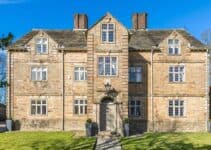A stone cottage has an undeniable charm, and many people will not settle for anything less. Because of this, stone cottages appear to have withstood the test of time.
Perhaps the rocks themselves exude this timeless serenity. When natural, ancient materials are used in construction, it appears as if the house has always been there.
Moreover, a stone cottage will outlast any other type of building by many decades, if not centuries. Stone is the undisputed king of building materials due to its timeless elegance, durability, and widespread appeal.

How Thick Is A Stone Wall?
A stone wall is about 18 inches thick and is built as a single row. The thickness may vary slightly based on the type of stone used and their layering technique.
For instance, older cottages were built using boulder stones, and modern-day cottages were built using quarry stones.
Boulders have an uneven shape, and the gaps in the wall were filled with smaller stones along with the binding motor. However, quarry stones have a better-defined shape and offer greater control over the size and thickness of the wall.
Also, the walls are slightly thicker at the bottom and gradually thin out as they reach the top. Doing so allows the wall to have a stronger foundation.
If the stone wall is built using a double-row technique with motor filling in between, the thickness of the wall increases significantly. There is no need for such an elaborate framework with a thatched roof.

Do Stone Cottages Retain Heat?
Heat tends to be absorbed and retained by solid stone walls. Usually, due to the thickness of the walls, there is not enough moisture present on the inside surface of the wall to pose a threat.
As a result, the walls may keep the building warm in the winter and cool in the summer.
The construction of stone-faced cavity walls is similar to brick-faced cavity walls. Since it is frequently impossible to get pieces of stone that are regularly proportioned and have a thickness comparable to a conventional brick, the exterior portion of the wall is typically thicker when made of stone.
The wall cavity will add to the wall’s weather resistance, helping keep water from penetrating the wall’s interior and providing a small amount of thermal resistance.
The cavity’s insulation will help cut down on heat loss even more. Even when utilizing stone facings, it is common practice to include a moisture-proof course in cavity walls.
Stone Wall Thickness In Mm
The construction of buildings has long employed stone, in all its varied forms, as a conventional building material. Historically, structures made of stone had thick, solid walls that were frequently at least 500mm thick (more than 18 inches).

Walls Made of Stone
For cavity walls—those with two distinct “skins” stitched together by some type of wall tie—stone has more recently been utilized as the exterior face. Typically, the stone used in construction came from sources close to the building.
There are various typical ways to build with stone:
Sturdy building with a combination of a) a disorganized layout of the stones, b) the use of exposed stones arranged in even horizontal courses, and c) dressed stone facings set in courses and supported by haphazardly stacked stones
Stone is laid in uniform horizontal courses on the exterior face of the wall in a cavity-based building method. Another variant is to utilize reconstituted stone blocks instead of the more typical brickwork as the front for cavity walls.
Traditional timber framing occasionally uses the stone as an infill when the main framework is exposed externally.
A solid wall’s performance as a structural element is unaffected by its construction type (coursed stone, random stone, dressed stone, etc.). The exact construction technique was probably determined by regional customs, the accessibility of materials, and the period during which the building was built.
Historically, the lime mortar was used to build solid stone walls; if internal plastering was used, it was also lime-based. The mortar made of lime is porous and adaptable. When it rains, moisture is easily absorbed by the mortar and can evaporate away, leaving the wall rather dry.
Most of the time, the walls are thick enough that not enough moisture can penetrate them and produce a problem inside. In contrast, groundwater is typically maintained because evaporation rates are lower than absorption rates.
Internal plaster finishes may become unattractive and stained as a result of this. Since the air within the property is still humid, severe moisture can sometimes cause health issues.
A damp proof course was not historically included while building stone walls, but starting in the early 20th century, it became standard procedure. However, a chemical dampproof course injected into a solid stone wall can seldom fully eradicate growing dampness.
Still, it will typically lead to a large decrease in the quantity of dampness in the wall.
Typically, the foundation for an older stone wall is little more than a straight line of huge stones set in a shallow trench. These foundations are more susceptible to subsidence and settlement.
Lime mortar’s adaptability is a benefit.
Deformation of the wall, if any, will be distributed across several joints, making any subsequent cracks nearly undetectable, even if there is some subtle structural movement. This contrasts with current cement-based mortar, where cracking typically occurs in one or two places and is typically fairly obvious.
Conclusion
The thickness of stone cottage walls has fallen from 3 feet in its older ages to almost 1.6 feet in modern times due to better design techniques and bonding materials.
When you pay attention to damp proofing, stone material, and construction technique, you can erect a lovely cottage in a peaceful setting for you and your loved ones to enjoy.
If the construction quality is high, it will endure for centuries with just modest repairs. Modern insulation techniques also aid in keeping temperatures at ideal levels in most circumstances.



